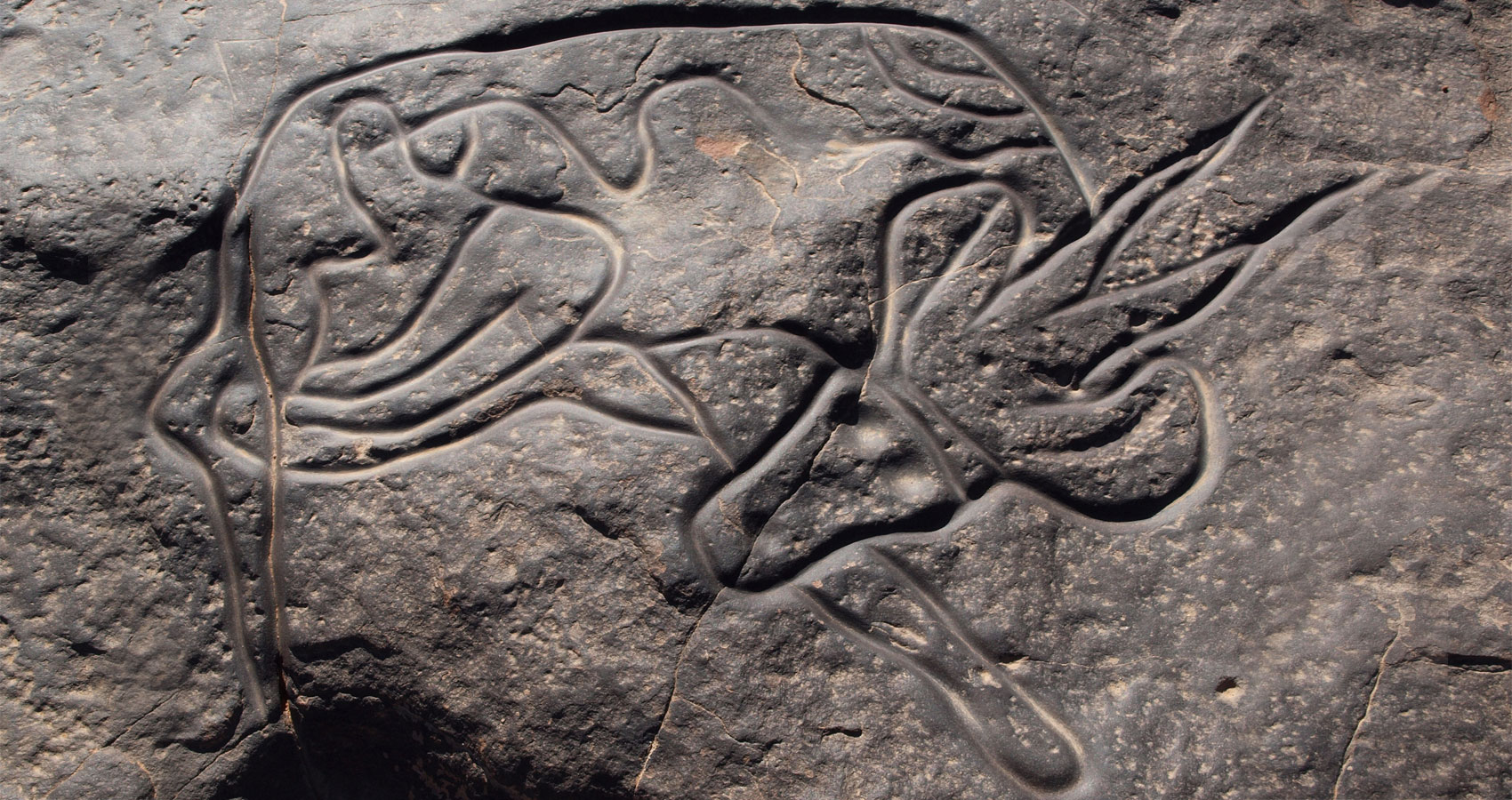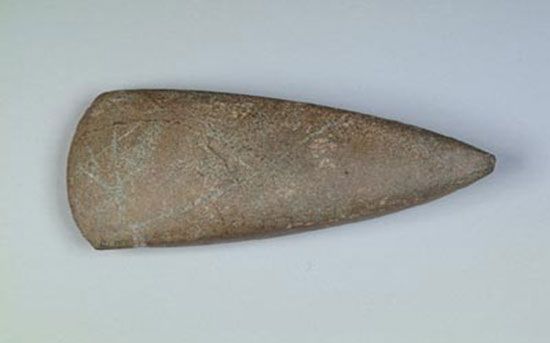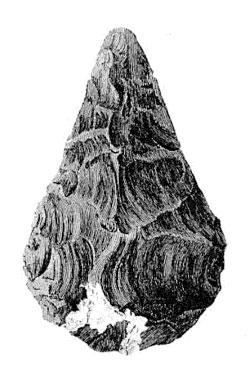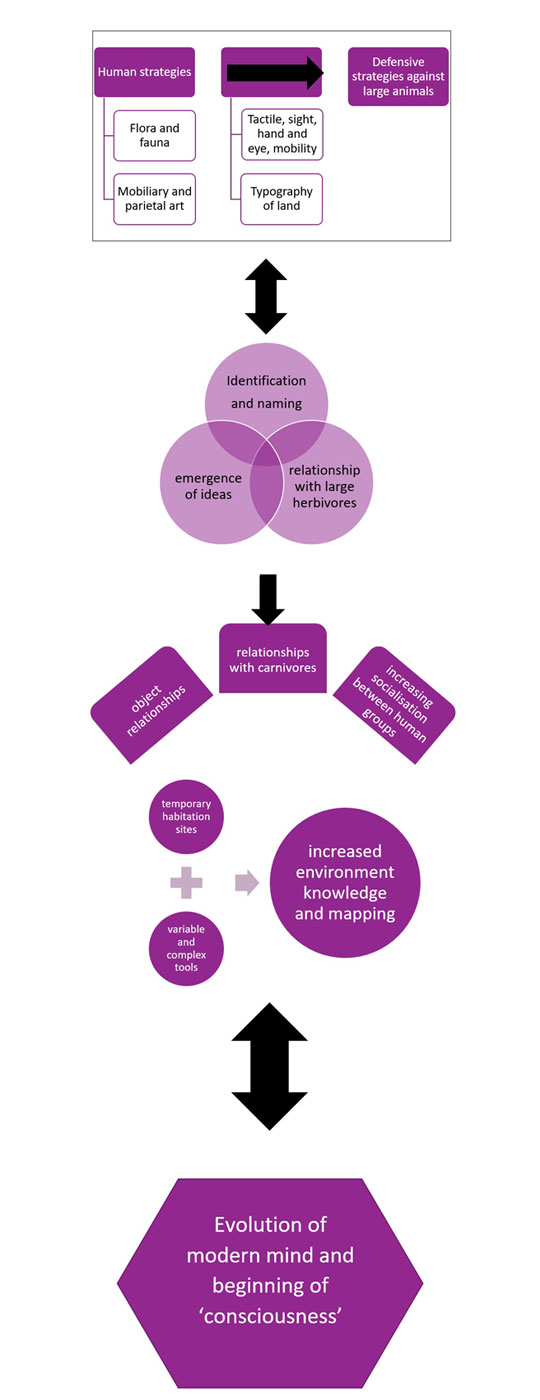The Myth of Mind and Consciousness III
The Palaeolithic
written by: Stanley Wilkin
@catalhuyuk
The resonating effect of artifacts on evolving mind as a group phenomenon.
Prehistoric Art: Transmitter of consciousness?
This section looks at the evolution of domestication, perceived as a consequence of human involvement with the landscape, environment, gendering and including aspects of human physiology expressed within constructs of space and time. In the process, mobiliary (portable) and parietal (cave) art in Europe is analyzed. These are presented as a means of transmitting ideas on urban communities, control and containment. The phenomenological principal concerns a relationship with objects and events, presented as one and the same, constructed upon space and time.
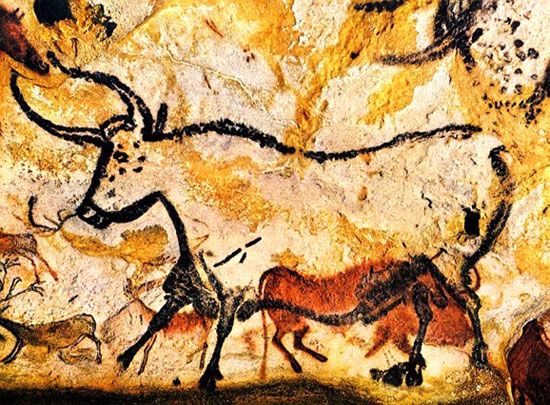 Parietal art established a relationship between viewer and referential, relationships between time and space of animals referenced, and possibly viewer and animal and death. Humans are always present through gaze alone. In the dark recesses of the cathedral-like caves, the paintings come alive when light is shown on them by the elite groups permitted to view them. Although they appear to dangle in space, this can also be viewed as each creature occupying its own space in relation to other creatures while also suggesting movement and change.
Parietal art established a relationship between viewer and referential, relationships between time and space of animals referenced, and possibly viewer and animal and death. Humans are always present through gaze alone. In the dark recesses of the cathedral-like caves, the paintings come alive when light is shown on them by the elite groups permitted to view them. Although they appear to dangle in space, this can also be viewed as each creature occupying its own space in relation to other creatures while also suggesting movement and change.
Space and time; the phenomenological conquest.
In this first section I hope to show how Neolithic farming communities resulted from intellectual transformations evidenced and transmitted by, in particular, the Palaeolithic Venus figurines and parietal art of Europe, which developed constructs of gender, the building blocks of an organized society, an understanding of space, and of the magical possession of land, allowing for the notion of settled existence to be developed. Portable, or mobiliary, and parietal, cave and rock art, allowed for the reflective processes of consciousness, encouraging multilevel interconnected internal and external reflective communication from which mind evolved. The latter I hold t be a group phenomenon functioning through self, the positioning of self through a shared understanding of events, achieved through the ongoing development of hand to eye mobility, greater social complexity, linked to a new awareness of topography enhanced particularized memory, and the emergence of linguistic capability based upon separation and differentiation. In this hypothesis, with immense simplification, creativity created consciousness. The organization of sensory perception within the framework of social complexity proved, and still proves, a unique survival tool. The world we now live in is one of our own making, creating increasing possibilities of planning and multilevel behaviour.
This section of Myth of Mind and Consciousness, in providing evidence for the above, will look at different views on brain evolution, the nature of mobiliary and parietal art and what early modern human activity Europe says about present day human development. It will consider present-day views on Palaeolithic Europe, the use of Palaeolithic art as a functional and ideational tool that operates to create levels of reflection.
The Palaeolithic occurred during the glacial period known as the Ice Age, centred on huge ice sheets covering North America and Europe. Maximum glaciation was around 22000 BP, but there were a number of warmer interglacial periods. Cave paintings are associated with periods of maximum glaciation and mobiliary art with the periods of warmer weather, suggesting responses to population density, the former reflecting small population pockets gathered around geographic points, while mobiliary art reflects wide population dispersal. Gamble presents a picture of several occupation networks embracing much of Western Europe, with the greatest known activity in the North Central, Alpine and South West regions, comprising modern day Central Europe, Spain and France. It is possible that Venus figurines emerged from North Central from where the earliest examples, prototypes of those later discovered throughout Europe, have so far been found.
Both mobiliary and parietal art forms are further defined by categorizing mobiliary art as assertive and cave art as emblemic, expressing individual and group values. Style is here considered ideational and functional, possessing communication properties that both provide modals with isomorphic properties and information. Although these categories are useful, the differentiation is probably anachronistic. The faceless Venus figurines demonstrate a lack of self that contradicts individuality and therefore suggests another paradigm altogether referencing the fruitfulness of women and life, the purposefulness of weaving for clothes and the probing spatial and touch dimensions.
Mobiliary art is usually three dimensional, providing spatial, tactile and visual responses, whereas touch in parietal art is less explicit and its representative nature contains one dimension described upon imagined space. By being painted onto rocky protuberances energy and life is given to representations of animals. Although the many variations can be divided into ideational and functional, it seems likely that each example possessed both. Incisions on an ungulate bone may provide information on seasonal game but gain emphasis as a consequence of the material used, providing information thereby on group identity. Palaeolithic symbolic activity was more varied than parietal and mobiliary art, reflecting local social change and interaction within groups, establishing recognizable perceptual responses shared by different groups over considerable geographical distances.
Throughout upturn periods in the glacial record, large game seems to have thrived, although like modern humans, occasionally driven out of Europe by the expanding ice sheets and intense cold. Human groups and fauna returned during each warm period from refugia in the tip of Spain, Italy and the Carpathian area of Eastern Europe, perhaps drawn back to historic sites established in the group memory through the recall of painted caves and accompanying ritual. This may be one purpose of parietal art, which on one or more levels was a celebration of time and place.
Cultural events in Palaeolithic Europe were probably a localised phenomenon based upon glaciation pressures, although European Palaeolithic culture stretched into Russia and Siberia. Neolithic Venus figurines are probably a continuation of that culture, providing ideas on sedentary lifestyles, possibly promoted through religious experiences, that underpinned the villages, towns and ritual centres of Anatolia, c9000 BP. The juxtaposition of animal and female iconography may be coincidental but equally may reflect evolving concepts of the internalized and externalized world of early modern humans. In Spain, for example, the above cultural trends coupled with aggregation led towards a sedentary way of life. Although Ian Hodder connects developments in Catalhoyuk with habitation of caves in the nearby mountains, differences in time should not encourage myopia, nor should we deny that certain iconography, female and animal, retain power throughout several millenium.
Although similar cultural developments to Palaeolithic Europe may have occurred elsewhere the evidence is thin. This may be due to terrain as for example in the Near East far fewer cave or rock paintings have been found, (Bahn, Vertut, 1988). European Upper Palaeolithic art provides, at present, greater abundance and complexity, but in order to provide a wider examination this section will include Upper Palaeolithic parietal and rock art found outside of Western Europe, noting similarities and differences. In order to induce perspective, it should be noted that rock painting discovered in Africa predates any yet discovered European parietal or rock art. Nevertheless, the arrival of modern humans in Europe, c40,000 BP, is noted for the expansion of human activity and explosion of cultural artefacts and behaviour, including decoration, iconic art, musical instruments, bone, antler, ivory tools, habitual architecture, and evidence of religious or transcendental activity.
Present day palaeoanthropologists are loathe to attribute, rightly so, this cultural intensity to physical changes in the brain, and yet such exponentially vigorous behavioural change is rare within human populations of the period. Although similar developments in Africa are stressed, these do not amount to a substantial contribution. This section offers one reason for the extensive symbolic activity of Palaeolithic Europeans, involving greater social sophistication established amongst widely separated groups. Nevertheless, European Palaeolithic parietal art required the invention of different coloured paints in order to exist, providing thereby representations of movement and power beyond the limited symbolism of red ochre.
Venus figurines, most widely produced during the Gravettian, certainly appear t have originated in Europe and I suggest were instrumental in the formation of early constructs of settled existence, based upon a relationship with the earth, penetrating and manipulating it, and possession of locality. One of my propositions in this section, based on current hypothesis on the terrain from which human beings emerged and also of human physiology, is that modern human preoccupation with space developed from human bipedal locomotion and the habitation of complex environments for which we were originally designed, enabling hominins to develop strategies for all kind of conditions, trees , water and rock faces. Winder et al have provided convincing evidence that human physiques were designed to navigate all kinds of terrain, not simply open plains and that hominines needed to identify a number of features, computing distance, relationship and value to both individuals and group. In order to survive we developed a multi-dimensional view of the environment in which hominines evolved, fully aware of the presence of carnivores, hominines probably assessed distance, animals in the vicinity, established landmarks, especially places of refuge. Against the idea that we evolved in savannas are our relatively poor vision and sense of smell, which all savanna animals appear to possess. The values inherent in one topography are different to those in another, requiring identification and differentiation. Human consciousness consists of differentiation, implicit in both tool making and language development.
Acknowledging the above, I will look at evidence that people in Europe and the Middle-East had already established settlements in the Upper Palaeolithic (Marshak, 1997) and Mesolithic times, thousands of years before the introduction of agriculture. There is evidence of well-constructed huts from c31,000-32,000 BCE, which housed multi-family groups, suggesting a ‘highly structured pattern in the organization of human settlements.’ Recent evidence has shown that settlements existed in Doggerland during the Mesolithic. Nevertheless, changes in the environment, from the neo-thermal period c12000 BCE, changes in cereals, and in concepts of space, were I suggest necessary before the construct of settled life was both widely experimented with and preferred. Tonge for example suggests that the melted ice that had once covered most of Europe swamped land, i.e. the Persian Gulf, which had provided an almost idyllic existence for hunter/gatherer societies, causing human communities to retreat into less suitable environments where other strategies had to be developed. Certainly, the depletion of the large migratory herds and other large prey may have meant that human groups had to transfer their attention to smaller prey, encouraging different strategies to be employed. Smaller prey tends not to migrate.
Upper Palaeolithic People, their lifestyle and beliefs.
The Upper Palaeolithic European peoples are split into the Aurignacian culture ending 28000 BP), Gravettian culture (ending 22000), Solutrean (ending 18000) and finally the Magdalenian. If these cultural changes do not indicate changes in peoples, they suggest wide spread exchange that operated to some extent within clear geographic boundaries, the centre in France and Spain with the periphery northward in Ukraine, Russia and possibly Siberia.
We have considerable evidence on the life-styles of European Upper Palaeolithic peoples obtained from the remains of meals and tools and weapons, although there is occasional dispute as the split between Neanderthals and modern humans. Contrary to mtDNA evidence, Robert G. Bechnarik believes that modern humans emerged through the gracilisation of other human types, including Neanderthals. The notion that modern human behaviour evolved amongst several human species rather than arrived with complete potential with homo sapiens sapiens is attractive and probably more closely in some aspects fits the actual case. There is evidence too that mankind continues to intellectually evolve, although such an assertion must not be restricted or specific to ideas of intelligence. Certainly there is evidence of a Neanderthal presence near the parietal art of France and much of their behaviour, normally associated with modern humans, predates our arrival. Nicolas Rolland provides extensive examples of technological achievement including levallois flaking, the possibility of art but on perishable material, and limited symbolic manifestations. The revolution that occurred in Europe might have been the result of cultural stimulation between two human species. It seems possible that some Neanderthals were assimilated into human groups, their specific cultural traits absorbed. There is evidence that Neanderthal’s invented bone working.
We know that Upper Palaeolithic humans hunted large herbivores, were cannibals, and probably ate berries, roots, fruit and mushrooms. Like all other carnivores, they killed the weakest first. Although we tend to identify Palaeolithic peoples with hunting, most illustrations of the period show that side, the gathering of foodstuffs by, I assume, women, more restricted to place, children and the elderly, may have equally established a group’s perspectives, although this is evident mainly in the Venus figurines. Often, they lived in tents. Recent investigations have revealed evidence of weaving with plant fibre to make clothes, cordage, nets, and basketry, indicating that clothes were probably both light and warm. Hunting was done with spears as bows and arrows were not invented until later. The lack of tension projectiles encourages a greater intimacy with the prey, an involvement in their deaths. The spear is an extension of the hunter, whereby the hunter and prey fuse. The Brno assemblage, c23,680 BP, shows a wide variety of animals amongst the grave goods, mammoth, rhinoceros and reindeer, as well as a shell headdress With such a plethora of prey to select, some animals appear to have served only a symbolic purpose, defining human nature rather than filling human stomachs. In Britain, the horse, although abundant was not, as now, eaten. Palaeolithic rock art depicts large animals, which change according to time period and location. At Chauvet the earlier cave paintings display a fixation with dangerous animals while later examples concern large herbivores. Speculatively, this may have been a consequence of human reduction and subsequent control of large predators. At Perigord the art is abstract but shares the concern with female symbolism noted at most other sites. At a glance, their lives appear to comfortably fit in with Maslow’s hierarchy of needs, the basic needs of security, sex, shelter and food, with in addition a need for meaning but into this overview can be included a people who enjoyed themselves, with gatherings, music and dance.
There is evidence of their thinking in their art, but, as with other evidence such as the above, there are clear difficulties with interpretation and guesswork coming into play. It is an exercise worth doing. The hunting of large animals indicates a relationship with such creatures and through them self-definition. Knowledge of large animal behaviour no doubt developed, recorded in many ways that have now disappeared, music and dance were undoubtedly common methods of communication, but also in incisions on bones, rocks and antlers and perhaps imitation and assimilation of such behaviour. Hunting in packs, thereby negotiating social ranking, humans had long used but also improved upon from observing lions and wolves. For humans, hunting was complex involving the preparation of weapons, the hierarchical process of knapping, selection of the time to hunt and location of prey, social rituals before and after, perhaps involving drugs and shamanism. Within this process is a relationship to the environment and its fauna. Of consequence is the creation of relationships with both prey and hunter.
The interdependent nature of dogs and humankind is based upon their shared characteristics, as the proximity of other animals determines our relationship to them. Specie centred behaviour and identification would be less likely to have occurred within such a multi-specie environment. Umwelt, the concept that modern humans acquire a habitual response to the environment, similar to instinct, produced by acculteration as understood by Herder, requires many thousands of years with behaviour shaped in accordance with the environment. Behaviour traits are transferred between individuals and groups, and absorbed from the fauna, not just from nearby human groups. For example, a painting of a lion pack in Chauvet caves provides a template for successful organized behaviour.
A concept of the living and dead would have been far less clear than today, developing through the use of caves and through a changing relationship with the earth and geography. Space was constructed outside of observable reality, beyond the material and animals that surrounded them. Lewis-Williams believes that this was done through drugs, but may also have occurred as a consequence of material restructuring whereby artefacts intimated reflective spaces beyond the immediate presence and use of objects.
Into the pot must be cast their relationship with large and extremely dangerous carnivores, which require containment and respect and, in the earlier part of the Upper Palaeolithic, with Neanderthals, a separate human species. Once this group had died out, human beings could investigate their separateness. Upon all this remains an obsession with time, important for hunting and survival in such a competitive environment and evidenced by their art. Knowing where game will be at any point in a season is essential for efficient hunting. The recording of such knowledge is evident throughout this period.
Mobiliary or portable art appeared early in modern human colonization of Europe and may be a continuation of developments elsewhere, of which there is at present little evidence. A green bracelet found in Siberia dated to c35000 may indicate a shared propensity. Power writes that the human use of iron oxides began amongst Homo heidelbergensis and that the evidence for its use by Homo erectus is not sustainable. In Africa, reds, browns and yellow were used. Developments in Europe may have constituted a reaction to the environment in which early Europeans found themselves, or new cultural or physical developments rarely seen in other parts of the world. In Namibia, c 30,000 BP, art was created on flat surfaces and also at about the same time on 7 stone slabs was incised animal figures. But until 13000 BP there is little evidence outside of Europe. At this time beautiful animal paintings can be found in Egypt. Although there were long lasting artistic conventions, Upper Palaeolithic styles or choice of subject changed in some aspects from one cultural era to another. Aurignacians preferred the more fearsome species; woolly rhinocerous, cave bears, mammoths and cave lions. Fish, snakes, wolves are rare, as are the sun, moon and stars, huts, mountains and humans. Of the last of these categories, of the 702 known representations of people, only 74, a mere 10.5 %, are men. Also, men and women are represented as naked, with a concern for exaggerated reproductive and nurturing organs. It is a reasonable assertion that those animals pictured throughout the Palaeolithic were iconic, and not always indigenous to the locality, either killed off or existing in small numbers. This need to recreate animals for symbolic purposes is repeated in Catalhoyuk, Anatolia, during a later period, where the leopard became central to worship. This area also engaged in extensive female symbolism. Although many archeopalaentologists believe that wolves inhabited Europe at this time, there is little clear evidence until the late Gravettian or Magdalenian. Rock contours were employed in the paintings, and different chambers and passages were used for different purposes.
Lewis-Williams and Clottes (2007), describing Palaeolithic thinking, believe that Upper Palaeolithic art had a religious purpose, especially as many cannot be easily seen. Parietal art appears to have been designed for specific events or people and not for public viewing. The above writers believe that the artistic consistency indicates religious belief held over a period of time. If this is so, they may have functioned separately from other forms of Palaeolithic art identifying a spacial plane outside of direct experience but obtained from extrapolating everyday phenomenological experience. The identification and employment of geographical space, the identification of spatial differences between individuals and between groups, leads to an identification to spheres after death or to other projected worlds, such as beyond the darkest recesses of caves. The above writers connect this to shamanism and mind-altering drugs. They do not, I believe, point out that once light is again cast upon these paintings, the animals pictured appear to come to life, thereby instancing another attempt to negotiate the unknown variables of life and death.
The Paleolithic and Mesolithic cultures of Europe developed powerful intellectual constructs, displayed by their artwork, that allowed engagement with the environment and with themselves. Cultural and psychological changes motivated these early cultures towards a settled life, which may have occurred without the invention of agriculture that emerged in its most intense early form in the Middle East. Prehistoric art work from Asia, apart from the remains of the Nafufian tradition of present day Israel, as I’ve already noted, is less easy to find, and probably less assiduously looked for.
—
Language is considered a behavioural trait, and there is a connection between hominin industries and the evolution of language, which is generally accepted by palaeoanthropologists such as Leaky. For example, in order to convey the complexities of knapping, the instructors developed syntactic and grammatical equivalents of the multiple abilities of lithic tools. Language and lithic implements are interconnected, part of the same evolution process as prehensile hands, stereoscopic vision, articulating phonic apparatus and a linguistic brain (Vieira: The knapping processes acquired latent capabilities reflecting on relationships, that of knapper and disciples, knapper and performers, plus also the potentiality of both use of and actions of tools. Through a biocultural evolutionary feedback, these reworked hominin social biology. Parker and Milbrath hold that ‘human intelligence, technology, and language work together as an integrated functional whole’, conceiving the process as integral to planning theory. They have thereby considered planning theory, developed by several commentators, including Miller, Galanter and Pribarn (1960) and Newell and Simon (1972) ‘Human Problem Solving’. Through a number of identified processes, planning, as evidenced in tool making, is seen as the trigger towards conceptualization, the procedural knowledge required for knapping leading to declarative knowledge that involves symbolic thinking. Dilisi constructed different planning types that happily accorded with Piaget’s understanding of children’s development, while seeming to omit the environment that early humans inhabited and the necessity of surviving amongst large, dangerous animals, which no modern child is remotely capable of doing. When a child first employs a language they use it to fix and isolate goals, but also surely to identify relationships as the Object Relations School of Psychology remind us. Children only plan when they reach periods of independence. Meanwhile, James Langer stresses the importance of combinativity, placing objects into categories, and the development of recursive cognitive development, extrapolating levels of knowledge differentiation. Although once again Langer compares these with child development, this is only possible with language, but does not necessarily mean that these exist in a hierarchical state of human cognitive evolution. Once again, Langer describes these as integral to individual brain growth without linking them to the surroundings. While Langer insists on the hierarichal dominance of cognition over language, there is no archaeology in his model beyond the processes necessary before the emergence of cognition and language.
While language is a medium for declarative planning, it probably evolved prior to the frequent use of reflective thought and lies within the processes of group planning, relationship identification, and population expansion within limited areas. Language represents the processes of separation of group and environment, group and group, individuals and actions. In fact, without the latter the technical evolution is impossible and also unless one possible survival strategy is identified it becomes difficult, but not impossible, to consider others.
Before looking at the cognitive importance of knapping it is necessary to mention that some archaeologists dispute the identification of pieces of knapped stone as artifacts but suggest they are core material from which flakes were taken. Nevertheless, I am not convinced that if true this lessens their importance. Knapping stones requires, unless we consider hominines as automatons, a concept of an end result within the stone, even if each was chosen for its initial shape, must have existed, although I agree that language is not necessary to achieve results. But what else is there upon completion of the hand axe or cutting flakes. As suggested above, a relationship is set up between knapper and those around him/her that separates them from others, even if only during the process. It may be that not every hominin had such ability and therefore it provided evolutionary/sexual advantages. The lengthy expenditure of time places it within declarative planning as the beginning and duration of each knapping process involves potential or possibility. Each tool includes a code of group knowledge, widely spread throughout hominins.
Palaeolithic axe heads: the shapes are similar to Venus statuettes. The linguistic, social connection, and comb nativity is significantly greater in the statuettes but serves ideational functions begun but not expanded upon by axe heads.
Holloway believes that the sequence of actions involved in the removal of flakes from cores is structured like syntax. Unlike simian construction of tools, hominins have produced greater variety but also have normally consisted of distinct parts, of variable usefulness, which ‘fit together to make a functional whole’. Early on, hominin tools acquired form, a cognitive step of immense complexity. This form was henceforth in the mind of toolmakers, who, according to Reynolds (1993) functioned within social cooperation, working together to achieve form. According to Reynolds (1993), the combination of social cooperation and purposeful rather than contingent tool making divided hominins from chimpanzees. Further, hominins were able to create polylithics, combinations of lithics, haft and point, or haft and axe head, which simians are unable to do, as they can also combine words to create new concepts, thereby effecting grammar. Using a stone to create a new form out of another stone is therefore analogous to grammar. While language was not necessary in the manufacture of tools, as the process involved combinations and social cooperation, it created greater efficiency.
With these ideas in mind, I have constructed a diagram reflecting later developments based upon that Antonio B. Vieira’s diagram, informed by the belief, shared and examined by Ralph L. Holloway, that the brain evolves in accordance with stimuli. Once change was effected in the brain it was fed into the human genetic programme, increasing social complexity, which then had a feedback effect.
Hominin
The processes are heightened involving greater combinativity, complementation, purposeful planning and wider more populous cooperation networks based upon tool creation and the acquisition of form. In this model, consciousness is a side effect of these processes conditioned by the creation of artifacts. At certain stages of hominin evolution different aspects may have been unconnected or weakly connected.
Modern
All the above constituted the Upper Palaeolithic mind, leading to constructs of domesticity.
Of course, while the above provides one view of language involvement within the process of material alteration, others view knapping, for example, as a sequence of bodily techniques, learnt as a series of gestures, with materials being metaphors not cognitive templates. This view resembles sculpturer’s belief that they merely release the form from the stone rather than approach stone with a fixed notion of what to achieve. The techniques therefore are important, allowing, over time, for increased efficiency. While we neglect body-memory, focusing all attributes within the brain, the knapper still visualizes a result, assigning purpose to sharp slivers of stone. The relational context and rational context are therefore still intertwined (Gamble, 2007).
—
There were many parts of Europe where cultural activity remained practically invisible. From the available evidence there appear to have been only a small number of people within Greece during the Mesolithic period, with a rapid increase in population at the beginning of the Neolithic period, c7000 BCE. During the Mesolithic period there appear to have been large areas of Greece which were unpopulated. Crete and many of the Cycladic islands were probably empty before 9000 BP, and Anatolia was probably connected to Europe at this point and was more likely to be directly influenced by refugia groups nearby during periods of glaciation. Although the later impoverishment of Europe, losing major hunting grounds to flooding, would have prevented substantial technological improvements its symbolic engagement shifted to or was re-established in Anatolia to be continued as a highly successful survival strategy through the stimulation of efficient co-operation between groups.
The changes in perception, which may have accompanied the agricultural revolution of 7000 BCE, with a corresponding change in attitude towards the land, and humankinds’ relationship to the land, perhaps also the introduction of fertility deities as objects of worship, may by itself have encouraged re-colonization of parts of Europe. Space itself may have been redefined.
Prehistoric Art.
Through our knowledge of present hunter/gatherer societies and an understanding of Palaeolithic societies, in particular Gravettian artifacts and art, it is possible to reconstruct, with caution, these ancient peoples’ perception of their world. The concentration of cave art within a small geographical area may indicate a surviving pocket of humans as the ice closed in, but as Gunter Berghaus (2004) avers this is not exampled elsewhere during periods of high glaciation, and if so demonstrated Palaeolithic desire to remain connected to both past and present. From such beginnings, come religion. Berghaus similarly views the intense periods of glaciation and subsequent high population levels as providing the stress required for new social networks to emerge, and while this is undoubtedly true the emergence of mobiliary objects in central Europe several thousand years before maximum glaciation indicates other forces also at work.
The symbolism of Palaeolithic humans had local significance based upo ecological, economic and cultural reasons, serving as indicators for animal migrations, spatial markers, initiation rites and totemic celebrations. Markings on portable objects may have been notation systems, and personal decoration ethnic signifiers. My position is that notwithstanding the complexity involved in the production of Palaeolithic symbolism, the differences in locality, it provides evidence of an examination of and negotiation with the environment in association with growing concepts of human separateness from the environment, its identification as a specific entity through both animal and human form, the creation of a past that takes an institutional form and is often identified with the land, and to the creation of a changing relationship with the environment. This may have been done with the intervention of shamans or through some other process, such as group experiences based upon ritual or networking behaviour. As evidence for this view, Solvieg. A. Turpin proposes that Rock Art in Mexico and the USA provides evidence for cyclical nucleation as one possible step towards settled life. Palaeolithic Europe shows many examples of such nucleation as well as evidence for a shift towards sedentary life or at the least a changed perspective of the environment.
The prehistoric hunter/gatherer may have defined the land through the movement and location of game, associated with changes in sky-patterns, (Marshak, 1997), or/and the location of edible fruits, roots or cereal. They may have, like some hunter/gatherer groups today, invested game with ‘religious meaning’ and surrounded them with ‘ritual and taboo’, (Roger Scruton, Observer, 2004, no. 58). A topographical model of the tundra they inhabited was attempted through the connection of space, movement, or distance, and time through the signifiers of their art. The result was a topological construction that concerned the skies, the fauna, (they appear not to be much concerned with the flora), their relationship with the fauna, a sense of passing time, with the scarcely visible backdrop of the Ice-Age landscape. From the Aurignacian onwards human groups appear to have become increasingly successful, suggesting widespread organization and communication. Large sites appear to have been occupied which suggest the use by many groups. Through this they constructed a land/space paradigm. The speed and mass, in terms of individual and group volume of game, of distance, and location, may have defined the nature of space. The evidence for this relies upon interpretation of mobiliary (Marshak, 1997) and parietal art. The development of language in its role of complex signifier, whether perceived as external or internal to the group or individual, probably increased under the pressures of social complexity, if such complexity occurred, and the desire to identify the environment. Language, I suggest, at this stage may not have existed as a fully developed signifier in the Lacanian sense, strictly indicating an immutable connection, predicting past, present and future cultural perceptions, but functioned indirectly through the characteristics of the fauna and not through human-body images and relationships. Separation of people into individuals, where the other becomes the object, inhabiting recognizable traits, may not have yet occurred as there appears little developed referential groups or activities yet constructed. The human group was not separated sufficiently from the fauna and therefore human psychology based on the self or defined through the human form did not exist. Often the human form was apprehended as both animal and human, the animal part a metaphor for unidentified human traits. There was perhaps no other way to identify Self in this early period of human construction of its own nature, except through fauna. The nearest yet discovered object that comes near to constructing a plausible human identity is a human marionette discovered within the Brno 11 assemblage, which at the same time as describing human physical attributes may also have functioned to understand the differences between life and death. Sanders judges the man buried here as a robust type with Neanderthal characteristics.
The Brno 11 assemblage may, according to Timothy Taylor, indicate a tableau involving a ritual killing or sacrifice, providing emergent relational structures with physical form. It is possible that all or many early burials discovered with goods have nothing to do with emerging religious ideas but signify social evolution, indicating forms of thinking, group memory enhancement and of record keeping before writing.
The idea of an ‘awareness of Self’ evident from the Upper Paleolithic period in Europe based upon bead decoration, or other forms of art specific to body adornment, of any description, I believe would be unlikely in a culture that defined itself by the natural world. Such adornments were perhaps little more than specie adornment with little connection to individual self-imaging. The messages conveyed were between groups, as many still are, and not of individual expression. While beads may signify individual display this was perhaps done in the context of ritual behaviour or group conventions. As during warm periods human groups expanded over a greater area, in smaller bands, individual decoration would have more likely signified membership of the band or larger group. A better case can I suggest be made for tattooing, although tattooing in prehistoric societies appears to be related to the communication and preservation of information and perhaps not for display purposes, looked at rather than gazed upon, the individual a conduit of information not of objectifying (Freud, various).
Although this is a matter I will discuss at greater length later, representative art, by which we in the West still judge our own efforts, is not directly connected to universal perceptive traits but may be culturally based. Research has shown that humans selects what they see. Selection of detail, naming, allocation of traits is important in the identification of the environment, serving human negotiation and control of the environment.
Defining Space.
One settlement strategy of Paleolithic humans was to establish a home base camp, which was perhaps frequently changed to other parts of their territory, with transit sites for the exploitation of a region. These would be on the edge of a grazing land, or some other landscape feature such as a marsh. From these site an area was exploited, and the animal herds controlled. There appear to have been two kinds of settlement strategies, the hunter-collector, which seems to have meant transit camps placed at a greater distance from the home base, and gatherer-forager, where food eaten at home base was found or killed near to the main site. In Northern Italy the harvesting/hunting of Ibex involved the use of yearly used sites for cutting up the carcasses and preparing them for transportation to settlement sites in nearby valleys. This represented a small, local industry.
A topographical understanding of the landscape was necessary for the efficient exploitation of areas, the position of grazing land, especially if the group was visiting an area it hadn’t visited for a generation or two due to climate change, marsh, cliffs, or rocky outcrops, but there appears to be no clear evidence for crude maps, or any interest in the landscape.
The occupation of or appropriation of sites by both genders is important in the development of concepts of space and of the development of the sedentary life-style. In Russia has been discovered a site in which male figurines have been found in one section and female figurines in another. The distribution of the population between sites may have required planning. It also may have reflected the manner in which Paleolithic societies were structured. If the home base was the preserve of women then this would have affected their position within their societies and helped to define gender-identity through separation. Equally, women may have been conduits of information between the camps. In some modern hunter-gatherer societies women participate in all aspects of the hunt except for the kill, specifically of large game, but will often hunt and kill small animals. Women are quite capable of operating together as killing groups.
It is possible that the area between Spain and central Europe was inhabited by identifiable groups established by systematic information exchange among local them, alliance networks, fully fledged language, planning and prediction. These were established and maintained during seasonal gatherings involving feasting, trading, rituals, and perhaps unruly or competitive fighting and sexual activity. In this way, land was regularly used for the same or similar purposes and became connected with comparatively large scale human habitation signified by mobile art. According to Lewis-Williams hierarchies formed around shamans and rituals, and that the existence of cave art, formed for and used by an elite, is evidence of social struggle. In this way, through social dynamics in the formation of groups, emphasis would continue to be placed on the production of artefacts and of rock or cave art.
Space.
According to Hume (Treatise On Human Nature), space is constructed from the impressions of an environment, the juxtaposition of contours and colours, developing the idea of space. The idea once established appears to exist separately from the sensory impressions. A name and description is therefore given to a specific experience. It has become part of a process of identification, of knowledge. This provides us with an apt description of topographical space. Space is something within which we exist, with causal events providing sensory evidence for its existence. An area without causal events, a nothingness, only becomes space when causal events are discovered, for example at its edge. Hume and Kant’s concept of space appears to be two dimensional. The inclusion of time, in that we do not have a static relationship with space, makes it three dimensional. A walking human enters space, leaves it and creates it. The time taken to enter or leave space determines its shape. Individual or group relationship with space defines its nature and that of others as an element of that specie nature. A task-orientated conception of space requires reference cues understood as part of spatial coding, consisting of integrating converging inputs from various sources into reference cues that specify locations, directions, distances that a task demands. This may have been acquired as a consequence of evolving within a complex topography where many variables had to be gathered in any decision making process. It can also be seen in the planning process and language construction, suggesting that it is inherent within humans. Although Deacon suggests it is from language that we acquire constructs of time and space, language may result from a need to make more efficient these existing capacities.
The artistic endeavour’s of prehistoric humans, from the Paleolithic period onwards, I suggest , constructed a topographical understanding of space, which, once established, allowed for the alteration of the environment through combinativity. A hill provides a multilevel reference cue, as would a clump of trees. Altering either creates a combination that alters the cue, providing several more reference cues. Notations on wall paintings and on portable art objects perhaps provided symbolized information that displayed a construct of time and space (Marshak, 1997). An androcentric reality, although proceeding from Self, became established that had sufficient connection to other realities, for example certain prey and predator behaviour. The human predilection towards separation and differentiation fitted this natural phenomenon well. As an interlocutor was necessary to disseminate and decodify information that role may have been assumed by a shaman.
Over the past few years shamanism, see above, has been increasingly touted as a explanation for the existence of rock art, especially that in caves which appear to present examples of extreme intentionality, of art locked into ideas and even ideologies. The meaning of cave paintings seems to have continued for many thousands of years, disappearing only with the advent of agriculture. Shamanism includes medicine men, or women, witch doctors, and perhaps also wise women of early modern times. Shaman attributes can be found in the profoundly influential role of doctors in present society, media personalities and an assortment of charismatic professionals, in fact anyone or any group that offers healing insights or processes into society’s ills. The modern versions, as with the ancient ones, tap into religious, psychological, medical and theological responses.
Any construct, of space, of gender, once established becomes susceptible to change. Once a concept of space is constructed relationships between people, of an individual or group nature, are subject to definition. The construction of gender separateness, for example, is then possible, with the subsequent divisions of labour and power. The alteration of an environment, with space contained by homes and fences, animals confined into a separate topological space from human groups, also becomes possible. As an understanding of space requires the presence of mass, or volume, this was provided I suggest by the larger sculptures, models and cave paintings that appeared from Gravettian periods.
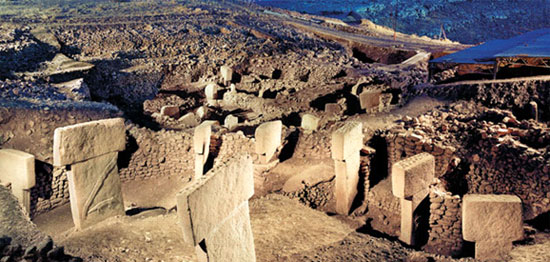 Gobekli Tepe in southern Turkey was built over 11000 years ago. The huge T-shaped stone pillars visible are often decorated with reliefs of fierce animals. It consists of 20 circular enclosures and may have been roofed. Apart from the painted caves in France and Spain this is the first known temple in which worship of some kind or of behaviour approximate to worship seems to have taken place. Of course we cannot be certain that Gobekli served such a purpose. The activities within the site may have been for other things. An alternative view is that the site served for gatherings, rituals connected to status and sex and that rather than worshiped the depicted beasts were totems, expressing group protection or references for local social developments and anxieties. As it is the earliest known large stone construction it may reflect symbolic perceptions of the material used, imbuing the ideas behind Gobekli with permanence. The use of stone rather than other materials while reflecting the local environment perhaps also expressed the power of stone and its employment for group defence. The site could have served to fix group identity and express concepts to do with the environment and human control of it. Gobekli was possibly influenced by European culture, expressed through a focus on dangerous fauna, or is evidence of cultural innovation within Anatolia and the surrounding area as a consequence of climate change and change in the surrounding fauna. There is no evidence of surrounding agricultural settlements and settlements so far discovered are those of hunter gatherers.
Gobekli Tepe in southern Turkey was built over 11000 years ago. The huge T-shaped stone pillars visible are often decorated with reliefs of fierce animals. It consists of 20 circular enclosures and may have been roofed. Apart from the painted caves in France and Spain this is the first known temple in which worship of some kind or of behaviour approximate to worship seems to have taken place. Of course we cannot be certain that Gobekli served such a purpose. The activities within the site may have been for other things. An alternative view is that the site served for gatherings, rituals connected to status and sex and that rather than worshiped the depicted beasts were totems, expressing group protection or references for local social developments and anxieties. As it is the earliest known large stone construction it may reflect symbolic perceptions of the material used, imbuing the ideas behind Gobekli with permanence. The use of stone rather than other materials while reflecting the local environment perhaps also expressed the power of stone and its employment for group defence. The site could have served to fix group identity and express concepts to do with the environment and human control of it. Gobekli was possibly influenced by European culture, expressed through a focus on dangerous fauna, or is evidence of cultural innovation within Anatolia and the surrounding area as a consequence of climate change and change in the surrounding fauna. There is no evidence of surrounding agricultural settlements and settlements so far discovered are those of hunter gatherers.
Mobiliary Art.
‘Meaning has both a logical and a psychological aspect. Psychologically, any item that is to have meaning must be employed as a sign or symbol; that is to say it must be a sign or symbol to someone. Logically, it must be capable of conveying a meaning, it must be the sort of item that can be thus employed.’ Suzanne Langer, ‘Philosophy in a New Key, A study in the Symbolism of Reason, Rite and Art.’
Mobiliary Art was often carried on the person, doubtless interchanged between individuals and groups. It appears to have predated parietal art by many thousands of years, and like parietal art was at first largely concerned with engraved representations of the vulva. It perhaps represented the communication between groups that lived in the open, and were mobile for long periods. The origins of human communication between groups situated at a distance from each other can perhaps be to traced to mobiliary art.
Although I am focusing upon Europe of the Paleolithic period I do not believe that art originated here. While there is no doubt that Paleolithic painting and models are art, a definition of art is required and this may be simply put as any mark or restructuring of inanimate material that suggests a conceptual purpose. Notations on moveable objects, discussed below, can be found in early human societies throughout the world, even those that preceded the societies of modern humans.
The period dealt with begins approximately 40,000 BCE until the Bolling-Allerod Interstadial, when the earth warmed up and the Ice melted. Within this period were fluctuations in temperature, with the ice expanding and retreating. The earliest period is termed, as already noted, Aurignacian, which lasted until c. 27,000 BCE, followed by Gravettian, which c.18,000 BCE. Whether these categorizations refer to anything other than archaeologists’ fetish, anal in character, for ascribing cultural changes of several millennium to precise dates is a question I will defer to another time. Although I will concentrate on the activities of modern human types I believe that the strategies of modern types were often little different from those of their predecessors.
Paul Mellars distinguishes the arrival of modern day humans into Europe not through improvements in stone working techniques but in their proliferation. This thesis does not concern tool making and shaping, except where its aesthetic values are allied to efficiency, but art. For example, the spatial abilities acquired through knapping were probably transferred to figurines and statuary. In both the spatial qualities of touch appear essential in the making of hand axe and Venus figurines.
The environment of the early Paleolithic period, with frequently expanding ice sheets, meant that much of Europe was tundra, wide open spaces full of large migrating animals. Only southern Europe was covered in forests. Although, no doubt, it may often have been a hard life there was a plentiful supply of fresh meat for the human inhabitants to eat. In fact, the evidence suggests that it was a successful culture, a ‘hunters’ paradise.’
Mobiliary art consists of, for example, ivory figures, decorated bones, animal tooth beads, and pebbles with notations incised upon them. Alexander Marshak has made an extensive study of Paleolithic notation, and, as a result has asserted it to be time-factoring. A shaped and engraved bone plaque from south-west France c.32,000-34,000 BCE Marshak believes is a lunar ‘calendar’, ‘showing phases of the moon over a monthly cycle.’ The earliest evidence so far discovered of notation comes from the Levant c. 54,000 BCE, although again this is not necessarily by a modern human type. An early form of mobiliary art in the form of a carved piece of volcanic tuff , already alluded to, was also discovered in the Levant and has been dated c 233,000 BCE, not therefore the work of present day human type. These artifacts Marshak describes as evidence of symboling, that is a manufactured image which signifies shared cultural values or communicates ideas, related to the society or the environment. They are images, or incisions, which carry a logic, an argument, which can be assessed by those it was directed towards within a specific psychological structure.
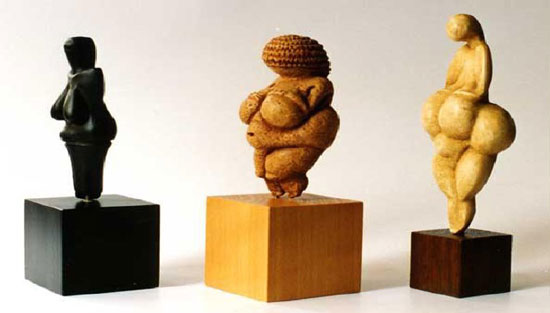
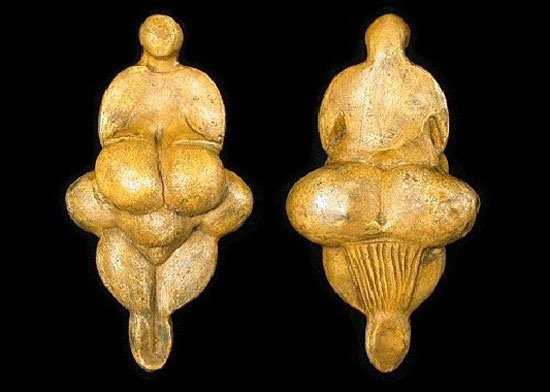
The statuette above has its point of gravity in the middle around the buttocks, chest and vagina, flowing downward. It may have been used for marking, possession of space, a kind of fertility tool. Domestication is constructed through female gendering, used within the sexual attributes of the penis, thrust into land to fertilise and possess. The viewer’s gaze focuses on the downward drift and on the fertility and discharge points, the female reduced to the physical activity of internal expulsion. The vagina is prominent but thrusting outward from closed thighs does not invite penetration.
Notation as a signifier of time. Marshak associates the employment of notations on pebbles with the Aurignacian population of Europe, some of whom appear to have migrated to the Levant c 30,000 BCE. The first known example of notations upon an image, in this instance of a horse, was discovered in the Levant, and appears to predate Aurignacion intrusion into the area. It is likely that so far more engraved objects have been discovered in Europe as a consequence of greater archaeological activity there rather than Europe being the area of origination for the technique. Lines were incised upon and around the image. Marshak believes that similar notations can be found on mobiliary objects and cave art throughout Ice Age Europe. Non-figurative motifs dominate in Palaeolithic art. Although it is now difficult to be certain what these motifs signified I believe them to be part of a construct of time and space, providing information on and defining the environment and human relationships with the environment. As many incised objects bear original images of animals the argument conveyed by the incisions probably concerns the animals. Horse images have been incised over at different times indicating perhaps the artefacts were used to measure time, with a concern on the successful hunting of the horse. The image of the horse may signify other aspects of their world, such as a change in the seasons, or a geographic location. The respective relationship of human to animal is often depicted. The image of an auroch engraved on an Anatolian pebble , c.14,000-13,000 BCE, was later incised over with the figure of a man thrusting a spear into the animals chest. This may have been predictive, indicating an understanding of the sequencing of events within time. Close inspection revealed later muzzles incised upon the original, a perfectly formed eye with a stream of tears flowing from it. Marshak believes this to be evidence for the killing and constant renewal of the animal. The flowing tears of the horse may have signified an evolving construct of the renewal of livestock within the process of domestication, which involves the symbolizing of future events attached to the present, and/or contain religious symbolism bound up with the worship of the auroch in Anatolia at a later point, which Hodder regards as about the control and containment of the wild within the process of domestication. Others, such as Bahn, speculate that as the pebbles and plaques were re-usable there may be only the most casual significance to their use. Many incisions he suggests may have been doodles. As I believe that any human activity usually signifies unacknowledged constructs casual use of any object within human culture is impossible. Bahn also suggests, in contradiction of the above, that because they may have been found in open sites in large numbers they may have played a part in rituals. The engravings on reindeer antler for example probably communicated information that signified the nature of the ritual and the characteristics of the wielder of the antler, produced at a certain point in the year. One engraved antler shows deer surrounded by salmon. While this may indicate the time when deer were at a certain location, thereby describing both time and space, it also signifies a relationship between the deer and the salmon, even if only a culinary one. The incisions represent communication between individuals and groups present or distant in matters of time or geography. Although some mobiliary art may have been done to pass the time in open sites, accomplished between events thereby marking those events, many, even those done for personal reasons, may have helped define the individual and group in the wide empty spaces of the European Ice-Age tundra., where geographical definition was difficult. The hunter/gatherers, in pursuit of game, required a local map, which perhaps was a topological map centered upon time, signified by animal images. In such an environment the sky’s features, which to modern eyes was at night alarmingly clear, would have been focused upon. These matters will be discussed again shortly.
Terracotta models have been discovered which date back to the Gravettian, c 22,400 BCE. The distribution of these on sites suggest a spatial differentiation (Bahn and Vertut, 1988: 83) with models of herbivores in one hut and humans and carnivores together in another. A hearth or oven for the manufacture of terracotta models has been found. The association of men with the wild, considered by Hodder, may be exampled by the above. Humans clearly connected themselves with the successful predators, those species at the head of the food chain. I strongly suspect that the beginnings of the construct of the sedentary lifestyle with its associated need to separate and define can be seen in the situating of terracotta pieces which perhaps suggests that living space was early being mapped out. Clay bison found in a cave, from the Magdalenian period, and a clay bear probably from the same period may demonstrate the containment of such animals within a community of human beings, (Hodder).
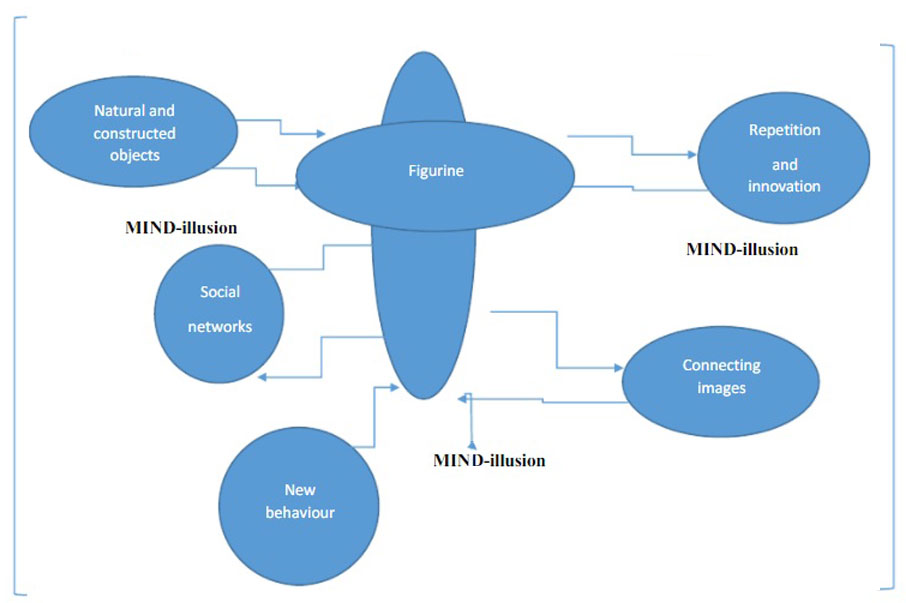 The illustration identifies the effect that figurines, and art work in general, have on the development of human consciousness. It operates a feedback loop, that produces resonances.
The illustration identifies the effect that figurines, and art work in general, have on the development of human consciousness. It operates a feedback loop, that produces resonances.
Incised vulvas. V shaped incisions have been discovered on rocks and pebbles dating from c.100,000 BCE, although not every expert accepts that these incision represent vulvas. Bahn and Vertut suggest that the perception that these represent vulvas owes more to the fevered imagination of middle-aged archaeologists than to reality. If they are vulvas the three-fold nature of the vulva, for the purposes of urination, sexual activity and for giving birth, may be the reason for its attraction to ancient men and women as a means of carrying information.
No other human organ has the same number of discrete tasks as the vulva. If Paleolithic people for example, like a host of their descendants, knew nothing about the essential male role in procreation then the vulva would have perhaps been seen as a source of immense power and mystery. There is also a connection between the vulva and domestication, in that the penis implants itself within the vulva as a plant is placed in the soil. The penis, few phallic sculptures have been found, can be seen as a stabbing, thrusting implement suited to hunting. It was perhaps associated with death, briefly transfixing an object, although we now know it gives life. Lacan points to the similarity between the climax in the sexual act and dying. The participants in the act are at that point at their most vulnerable, when awake, to attack.
A construct of sex, an understanding of sex and its place within the society, openly displayed or subject to ritualized social behaviour, may be evident in vulvac inscriptions, phallic artifacts and Venus figurines. The vulvas may have been engraved by women as an indication of their position within the community. Although the group’s short term survival depended on the hunt, the group’s long term survival probably depended upon women who foraged, made garments against the cold and hunted themselves. At some point there may have been a connection between lunar cycles and menstruating wombs. Women’s biological characteristics were likely employed in the developing process of time-factoring.
Zoomorphic Sculpture. These are animal representations found upon throwing sticks, batons, or sculptures without any specific or apparent utilitarian purpose. Some of these sculptures may concern the introjection of animal characteristics into the bodies of the human beings who own the objects, common to shamanistic practice. The lion-man for example, carved from a mammoth tusk, c.30,000-32,000 years old, and found in the Chauvet cave, France, appears to indicate ‘the human body as vehicle for the force implied by the head of the lion.’ (Jean-Pierre Mohan, Prehistoric Art, 2002, page 55). The individual or group which possessed the stature introjected the qualities of the animal into their psyche, while remaining human. This they perhaps believed made them more efficient inhabitants of their environment. The need for psychological change within group and/or individual can thereby be observed through identification with specific animals. The carving of the representation of an animal upon the horn, bone or tusk of another perhaps visibly constructed the metamorphosis between specie, whereby each shared in the attributes of the other. Zoomorphic sculpture may also have allowed the group to contain wild, principally carnivorous animals by introducing their representations into the human community, a symboling forerunner of the domestication of wolves and other animals.
‘Venus’ Figurines. Whatever the actual reasons for the figurines, and attendant female imagery, they have been for several decades part of gender politics. For example Camilla Power asserts that art, or at least the invention of paint, evolved from women’s desire to camouflage their reproductive status by mimicking menstruation. This places women central to the discussion of human evolution, which is usually too concerned with men. These arguments depend to some extent on the dangers to women of encephalization that recent scientific research has found to be a fallacy. Rather than the womb dictating the maximum size of a baby’s head, it seems that the woman’s body as a whole determines size upon reaching maximum resource capacity. The possibility that women were humankind’s earliest artists is rarely advanced but should be considered in the context of disguise and re-interpretation.
The Venus figurines, sculptured representations of steatopygous females, may have been part of a fertility cult. They appear to have been created within a few thousand years around 24,000 BCE and were employed until c14,000 BCE, although Bruce Dickson , an acknowledged authority, believes that they were restricted to c25,000 to 23,000 BCE, but more recent research, see above, identifies a much earlier beginning in Germany. White specifies that there are distinct differences in style between the Gravettian and Magdalenian periods, outside Dickson’s time range. It appears that Venus figurines were, unless new evidence emerges, a European phenomenon and have been subject to a variety of interpretations. While some interpreters have determined they are a form of ancient porn, others have seen them as evidence of a fertility cult, prestige items of a highly valued textile industry, and yet others as evidence of societies run by women. This section will consider the idea that irrespective of the validity of the above viewpoints Venus figurines represent a dialectic on lifestyle, primarily concerned with societal stability concentrated on permanent occupation of parts of the topography, of the control and containment of resources. Initially, different examples of the Venus sculptures and figurines will be considered and also the different perspectives.
The style of these figurines varies (Paul Mellars, 1994) but there is ‘a group depicting naked women in three dimensions with no faces and no feet.’ The figurines have been found throughout Europe, from southern France to Russia. They appear to have stylistic conventions in common, whether belonging to the above group, suggesting that they were part of the same or similar culture, although White (1997) raises doubt as to whether they all signify the same to the peoples who made them. They may also have been produced by a group for other groups. They have been found only on open sites.
Some writers, predominately of a feminist persuasion, (Stone 1977, French) believe that these figurines point towards the growing power of women within prehistoric societies, or were part of the developing construct of gender in increasingly complex social groups. Gamble points to their production at periods of increased climactic instability as an attempt to draw the many human groups together for survival. In this perspective, women express an ideal, the nurturing, protective mother ensuring the survival of her offspring would, if it existed, as part of a female construct.
A standing Venus has been discovered in Stratzing, Lower Austria, and provides the template for later examples. The earliest known figurative work of art is a Venus figurine discovered in Hohle Fels Cave, southwestern Germany, dating from the basal Aurignacian, portraying a woman with exaggerated sexual features. This figure is possibly related to shamanism, indicating the early development of the institution and thereby raising innumerable questions. Such as, did shamanism, if it existed, begin outside of Europe or did this particular form develop within, having to do with conditions within Europe? Was it in fact began by Neanderthals and inherited by modern humans? It provides evidence of being the precursor of later Venus figurines. Although female figurines are rare during this period, this and other artefacts point to the importance of women in group development and identification. Such evidence as there is, suggests that this form of female iconography originated in the area.
The comforting presence of the ideal woman/mother may have symbolized the departed warmth, recording and preserving it for the group’s memory, and/or the association of women with renewal, through childbirth, thereby predicting the return of a milder climate. Gamble presents no suggestion of how apart from through the statuettes these ideas might have been continued over several thousand years. Nevertheless I suggest that the hearth, walls, and warmth of the sedentary life is not too far removed from the intimate confinement expressed by this notion. There is some evidence of population increase within Europe from 28,000 BCE and the growing frequency of same site use which predicts a trend towards a sedentary lifestyle, (Prehistoric Europe). Bahn and Vertut (1988, page 163) assert that as few of the figurines appear to be pregnant, merely fat, which White disputes (1997), and only a small number were involved in giving birth, they represent not fertility but womanhood, or the fecundity of women. The steatopygous form of some of the female figurines is not uncommon in parts of West Africa, and may even have dominated amongst women in some parts of the western world. The possible erotic nature of the figurines, with its association with male dominance, is contestable as the figures appear to symbolize more than form, and the common appearance of the phallus in the art work of other cultures rarely leads to accusations of female dominance. Onian’s assertion in The Origins of Art that the tactile quality of the statuettes confirms their erotic nature ignores the tactile qualities of many reverenced artifacts, including crucifixes. The burying of the Venus figures in open sites again argues against any erotic purpose, as they would not have been seen or consequently salivated over.
White (1997) points to the association of female representation with birds in Siberia, occupying the same or nearby space, or in France with bison. In some cases two human faces share the same body or a human face is conjoined with an animal face. White does not speculate on the importance of either, but if earlier, long perished, paleontologists can see a male figure dressed in a reindeer skin, complete with antlers, as evidence of shamanism, with men of course predominantly involved in this kind of control of knowledge, than the female figure with a horn engraved into the inside of a cave (Bahn, Vertut, 1988) can be viewed as a priestess conducting a rite. It is worth noting, that engravings of vulvas appear similar to or could be bird foot prints. The bird may therefore have symbolized women.
Treading on safer ground I feel is Camilla Power’s (2004) connection of obese figurines with streams of potency, connecting the fruitfulness of obesity and menstruation, and the occasional identification with bison suggesting a connection to plenty. An engraved horse from Les Trois-Freres has a series of Ps along its side, which Powers suggests represent pregnant women, suggesting perhaps an association with potency and power.
Some figurines appear to have been designed for suspension on the body or elsewhere probably used therefore as amulets or fetishes. After offering this information and more White deduces that the female figurines were concerned with childbirth. The manner in which some of these figurines were buried suggests to White that they possessed immense power for those who owned or made them. They were he believes employed to ensure the safe completion of pregnancy, although the number of Venus figurines on transit sites may dispute this, although women may have featured on hunts, especially those of a duration of several months. White asserts that the figurines were probably made for individual women which accounts for the variation, but it appears to me that given the timescale involved, of at least four to six thousand years, and the distances between the discovered figurines, there is a relative lack of variation. Strong traditions were clearly at work, indicating equally strong constructs.
If, as White believes, the figurines demonstrated female control over childbirth through magic, the association of women and childbirth with magic would probably have given them immense influence within the group. This hypothesis is likely only if magic was accepted as a form of knowledge or as a means of controlling the environment during the Palaeolithic. Female influence was as likely to have been transmitted through their identification with renewal. The notion of women enjoying only a private connection to magic, without a consequent public role, suggests a modern understanding of women’s roles in society. In Palaeolithic times societies were probably open and gender roles within them more fluid.
I believe that women enjoyed a far more inclusive role in Palaeolithic societies. The beautification of some of the figurines (White, 1997, page 118) suggests a stronger role based upon more modern constructs of femininity, based upon sexuality, then White allows. Female sexuality need have had nothing to do with male dominance but could have been based instead on the fulfillment of women’s sexual needs and self-identification through those needs. The association of women with renewal may have given them a greater involvement in parietal art than even I have allowed, although the possible concern with renewal within parietal art may be evidence of male competition with women.
Female gendering (Davidson, 1997) was perhaps accomplished through an association with a static perception of time, structured upon the permanence of base sites (Bruce Dickson, 1990) rather than through the movement of the hunt. If, as Bruce Dickson (1990, page 103) believes the figurines are evidence of a cult concerned with female fertility, the female form an efficient machine for the birth and nurture of children, or (Stone, 1977) of a mother goddess, the creator of the environment, symbolising fecundity, than I suggest these factors alone were, through my previous analysis of the developing discourse upon gendering, capable of creating a construct that allowed for the development of a sedentary lifestyle based upon an intimate relationship with the soil that revolved around fertility.
The environment, was not simply the plane upon which game existed, or fruits and roots grew, but became associated with the developing female constructs. As the Venus figurines appear to have had ‘a special role in the home’ (Bahn, Vertut, 1988, page 86) the involvement of female-gender construction in the discourse, perhaps far too modern a term, on the sedentary life-style, is perhaps to be considered.
A figurine, discovered in Eastern Europe, dating to about 21,000 BCE, was found buried upright in a small pit (Bahn, Vertut, 1988, page 140), leaning against the wall of a hut, and facing the centre of the hut and its hearths. This may have been situated there to guard the space taken up by a household, a symbol of permanence. The hearth was where much of the most important daily work of the group was done, where the fire was located, food was cooked and pottery made. Later on metal was probably first melted here to form jewelry or tools. In its warmth it is likely statuettes were constructed. The presence of Venus figurines within such sites may indicate the separation of the genders, in terms of self and group identification, through the separation of gender-appropriated space. The symbolic marginization of men through the hunt may have encouraged appropriation of the hearth by women. A number of slender female figurines discovered in Siberia, c12,000 BCE, were aligned within square or circular half sunken buildings, which may have been houses. Around these figurines were items known to have been used by women. In another part of the site was found items associated with men. This appears to be clear evidence of separation of living space based upon gender. The ‘dame a la capuche’, a beautifully carved ivory head of a woman, with carefully delineated upper-face features, was found beneath a hearth. Doubts have recently been expressed about its authenticity although others have claimed it is approximately 30000 years old.
During a period of three or four thousand years the inhabitants of Eastern, Central and Western Europe may have defined themselves through womanhood or motherhood. This may have been a survival technique. These concepts may have involved several independent factors or functions, the nature of childbirth, which I will consider at length, and women’s possible nurturing role within the group. The latter should not be assumed. Many feminist authors, such as Marion French in her reassessment of women’s roles within history, have it seems to me uncritically and patronizingly accepted the nurturing role of women while neglecting evidence of other less pleasant female attributes. Freud and Jacques Lacan, two thinkers who concerned themselves with female sexuality, noted the variability and unquantifiable nature of female sexuality. Female responses to intercourse appear to be individual in nature, what suits one woman does not necessarily suit another. The scientific nature of this observation is open to dispute, as recent developments in Europe and America have demonstrated that women are equally capable of sexual objectification when financially independent and free of anxieties over pregnancy. Female sexual sensations are certainly located in several different areas whereas male sexual satisfaction is predominantly located through the penis. The male appropriation of fetish orientated sexual behaviour may be psychologists’ myth-making or an attempt by men to introduce variety into their sexual activities. A female orgasm can be produced in ways other than through intercourse or lovemaking in its other forms. A voice may be sufficient.
Lacan viewed men as fulfilling the nature of women/prime object rather than expressing independent characteristics. Men are usually the object, although Lacan specifies that the object has no gender, that lies beyond the centre of the woman’s relationship with the infant child, the physical world that symbolizes reality. Lacan romanticized the role of women, especially in as mothers. The central possessive role of women in their children’s lives may be a widely spread cultural development of recent providence, one which defines masculinity. In the context of this book for example, this means that if women appropriate the hearth men appropriate the characteristics opposite to the hearth, those of open space and mobility. The fixation of Freud and Lacan on the properties of the genders has to do with the psychoanalytical obsession with parenting, which may not have concerned Paleolithic peoples.
The dominant role of women within child rearing should not be assumed. I suggest such a role is the consequence of economic and social factors. Children may have been raised by all the members of the community, or by the old. Women’s roles within society could have been too important for their energies to be exclusively employed in the raising of children. Perhaps, once the woman had given birth, her job was done and others took on the task of rearing the resulting offspring. The lack of representations of children in prehistoric art may indicate their identification with the mother rather than the group, or the immediate unimportance of children, members who were fed but did not contribute enough within the group for the privilege. A woman’s death during childbirth, see White, was probably more of a disaster for the group than the death of a child. The hysterical ideas of Melanie Klein on the primal nature, both deeply subjective and impenetrable, of the child/mother relationship were probably not evidenced during this period or any other, owing more to the guilt feelings of Klein than any genuine insight into such a relationship. As much psychotherapy is predicated upon such an intense relationship existing between mother and child, for Lacan this relationship separates the subjective from the objective, it should be noted how difficult it is to find such a relationship represented within the Paleolithic. Symbolic use of children, for sacrifice or after death, appears to be a much later manifestation.
The self-defining of a group through womanhood considered above does not necessaril mean that within prehistoric societies women had power (Stone, The Paradise Papers) or held power as the notion of power may not yet have existed. Merlin Stone, (1977) a feminist writer, believes that the figurines indicate a matrilineal (mother-kinship) society during a time when the male’s part in procreation was not understood. This has credibility as only the true mother, of the parents involved, may have been known, the case up to the present day with the development of DNA testing. Colin Renfrew (1972:421-424) writing of similar figurines of the Neolithic period in the Aegean that may have displayed ideas on the sedentary life, which emerged within Paleolithic Europe (Bar-Yosef, 1997), describes how several powerful symbols, i.e. the sun and the sea, were bound up with feminine sexuality. In the Paleolithic this was most likely to be the moon that was symbolized by female figurines, their biological functions fundamental to early time-factoring. Aurignacian colonizers of the Levant may have taken these ideas to the Near East. Feminist writers like French and Stone who search for an historical construction to imagined female subservience frequently assert the existence of early Goddesses within the Near and Middle East which predated Gods. Mor Sjoor delves into this at length in her work ‘The Great Cosmic Mother, Rediscovering the Religion of the Earth.’ Of all these ideas on the nature of the figurines and of the apparent obsession with women throughout the Paleolithic I prefer the approach of Steven Mithen, After the Ice, A Global Human History 20,000-5000 BC, 2003, who notes that women were central to the survival of a group, while men were probably marginalized by the hunt.
Stone, 1977, connects the Venus figurines with ancestor worship, which she holds to be the earliest manifestation of a religious concept, but inhumation appears to have begun with the Neanderthals, and the remembrance of the dead in the Paleolithic period if it existed and was not simply symbolic without genuine reference to another existence probably remained a matter limited to a generation or so. Mithen points this out in conversations with Australian Aborigines. As there is no evidence of Paleolithic constructions that point to where individual bodies or groups of bodies lay, this remains speculation without much basis. More likely it seems is the possibility that Paleolithic people worshiped, if they worshipped at all, human-animal deities such as the lion-man as these could apparently bestow power onto the group and reflect the group’s environment. Stone hypothesizes that the Venus figurines represented goddesses who symbolized the human origins of the group. Again, I suggest that it was unlikely during Paleolithic times that the concept of ‘humanness’, which involves the separation of our species from other living things and thereby allows for separate definition, yet existed. The figurines may nevertheless have represented early constructs of continuity of human life, for example, that developed into paradigms of the settled life, and consequently were subsumed into the omnipotent characteristics of later goddesses.
In respect of the gender identification, referred to above, the burying of the Venus figurines within open sites may have been evidence of the connection of the renewal magic of women with the hunt, or/and of the association of female magic with the possible increasing male preserve of the hunt. As some of the sites could have involved festivals where many different groups converged for celebration the figurines represented values shared by all the groups.
Magical possession of the earth. As many Venus figurines have been discovered buried on open sites, and none within the caves, this perhaps suggests an association with the land which I will briefly consider.
It is possible that a buried object indicates the concept of group or individual possession of the land, in the manner that burial employs land for the possession of the group, representing an historical identification. Cemeteries later became villages for the dead. The space beneath the soil was perhaps also associated with the dead or the unknown. Renfrew’s assertion (1972) that these figurines were objects of worship amongst small groups or within households and were transported from site to site underlines their role in the groups possession of space, and of sedentary life constructed around a feminine construct, not exclusive to women or necessarily appropriate to them, of space from which men were not yet separated from. Settlement sites were acquiring properties beyond their practical purposes. The placing of revered or important objects beneath the soil indicates the spreading influence of the group and an enlarging construct of the environment. The space beneath the soil was claimed for the group. The joined, pointed feet I suggest served to position the figurines in the ground or in a tree to insert qualities into the area to ensure the success of the hunt, for worship or to ward off evil spirits. They may have in effect fertilized the ground, in a magical, religious and procreative sense, protecting and sustaining the group in a way that mimicked agriculture. The statuettes may have penetrated the soil in the way that the penis penetrates the vagina. It perhaps represented an act of possession. The figurines appear to identify the static nature of space and time through the downward, earthbound momentum of their shape, rooted within the soil, symbolic of the act of possession.
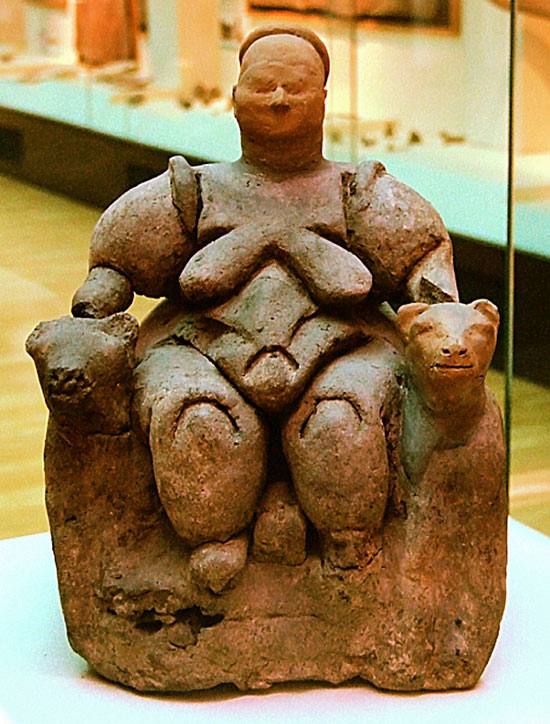
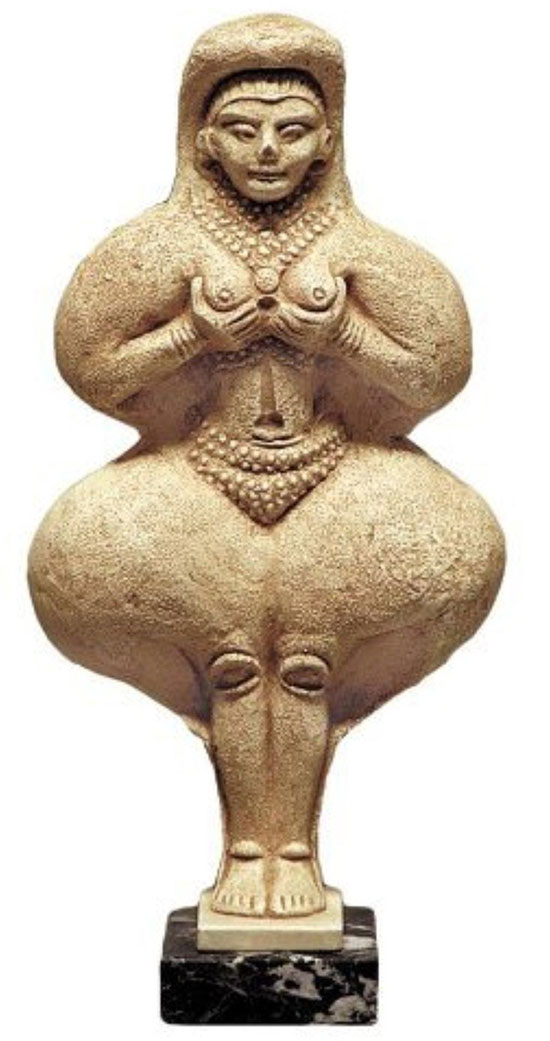
Form: Art gains much of its impact through form. For many in western culture a good example is Michaelangelo’s David. The form conveys the initial impact through association with ideas the viewer is familiar with. In the case of David, the biblical boy-hero, later king, the permanency of religion, and the figure’s ancestral and spiritual connection to Christ. After that other messages come into play, such as the beauty of youth, the longevity of youth through the material, the desirability of youth, the energy of youth, the potential of youth. The number of messages or signals build up and would, in some form or another, remain if the biblical references were somehow forgotten. The Venus figurines served the same purposes, providing powerful and connecting messages we have lost. This is an example of combinativity through form, first considered in knapping and the production of axe-heads. The difference is of greater mental and cultural expansion.
The earliest hand-axes bear a resemblance to Venus figurines and share a tactile quality. The power therefore of the hand-axe and spear point was transferred to the Venus figurine.
Conclusion:
In this section I have attempted to show how the development of mind occurred through the utilization of material objects, which both represent and energize mental depth and reflectiveness and the development of spatial awareness through negotiation of the environment and establishment of groups within a cultural hegemony over distance. Time was factored in through planning, menstruation, and observations of the moon. Through the processes of connectivity ideas emerged driven and directed by art objects and paintings. Drugs may have had a part in this expansion of awareness. Art is seen as expressing recognised form that allow concepts to continue over immense periods of time, the synapsis to human neural cords. Art also provided a means of separating animal and human, which throughout the Palaeolithic was interdependent. Human nature would not be independently defined until thousands of years later.
Western representative art, with a number of breaks, has lasted for only 2500 years and throughout has embraced, often with similar iconography, different religions and religious viewpoints and civilizations. Palaeolithic culture, demonstrating continuity although again with different phases, lasted approximately 20000 years and covered Europe and as far as Central Asia. It may also have influenced cultures in Siberia. Although refugia in France and Spain during glaciation periods may have resulted in a cultural cul-de-sac it is possible that the Carpathian refugia affected the Near East. This of course is only a surmise as there is at present no evidence for such a development. Clearly, the developments experienced in one area can be experienced, equaled and surpassed in another. The emergence of Venus figurines in the Near East is either coincidence or survival of concepts over time and distance.
Venus figurines provide the conceptual pathway towards domestication through the long term connection of the group to both locality and earth. The earth or ground was taken magical possession of and throughout the years the concept of domestication took ‘root’.
The concept of mind was nowhere to be seen as humans had yet to separate object and feedback loop to object or objects and each other. The number of reflective units was insufficient for the construction of the illusory-separateness and internalization of mental attributes. The faceless and eyeless statuettes do not signify an emerging separateness but express phenomenological points of connection between groups. The inability of Palaeolithic peoples to individually define each other, and their focus upon and skilful representation of the behaviour and form of animals, indicates a lack of humanness.
- A Strange Place - December 5, 2025
- The Puppet Dance - August 15, 2025
- Until I Stopped - April 23, 2025


